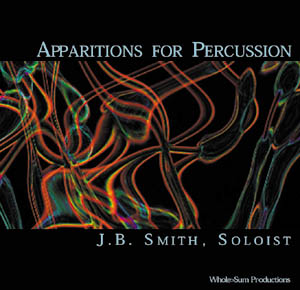J. B. Smith, Apparitions for Percussion Apparitions for Percussion features new works for solo percussionist performed by J. B. Smith. Track List
1. Joseph Schwantner: Velocities (moto perpetuo) for Solo Marimba
2. Daniel Lentz: The Apparitions of J. B.
3. Akira Ifukube: Lauda Concertata for Orchestra and Marimba
4. Todd Winkler: Stomping the Ground for Midi Percussion and Computer, Mov't 1
5. Stomping the Ground, Mov't 2
6. Stomping the Ground, Mov't 3
Album DescriptionJoseph Schwantner's "Velocities (Moto Perpetuo) for Solo Marimba" is a virtuoso work that displays technical intricacy, power and speed.
"The Apparitions of JB" features a MalletKat percussion controller interacting with layers of digital "ghosts".
Akira Ifukube's "Lauda Concertata", originally written for marimba and orchestra, has been adapted by Smith for soloist with electronic orchestra.
Todd Winkler's "Stomping the Ground" is an interactive drum solo for TrapKat percussion controller and computer.
Liner notes
"Velocities (Moto Perpetuo) for Solo Marimba" was commissioned by the Percussive Arts Society and funded by the National Endowment for the Arts in a Consortium Commission for marimbists Leigh Howard Stevens, William Moersch, and Gordon Stout. Joseph Schwantner, born in Chicago, is currently Professor of Composition at the Eastman School of Music where he has been on the faculty since 1970. He has also served on the faculty of the Juilliard School. Schwantner received his musical and academic training at the Chicago Conservatory and Northwestern University, completing a doctorate in 1968.
In "The Apparitions of JB For Solo Percussion and Multiple Digital Ghosts" the solo percussion part is very virtuosic, not only in a purely musical/technical manner, but in the technological demands it places on the soloist. The digital ghosts in "The Apparitions of JB" are musical echoes that do not function as actual echoes. These ghosts, like their humanoid counterparts, can do things that ordinary musical figures cannot. As a human ghost can walk through a wall, a musical ghost can turn itself inside-out, upside-down, or it can change its speed, its range, even its timbre. For example, something played by the human soloist might return seconds or minutes later in such an altered state that even the soloist might not recognize it. Other ghosts, especially when alone or in small numbers, are more easily recognizable. But when there is a whole roomful of them sounding about (sometimes one might hear up to 30 of them) even the composer has something to fear.
"Lauda Concertata for Marimba and Orchestra" was written in 1976 for virtuoso marimbist Keiko Abe. Akira Ifukube was born on May 31, 1914 in a small village in Hokkaido. He began his music career as a performer in the student orchestra at school. Then, while he was in college, he became a concert master. He performed many European classical pieces, but was drawn to Igor Stravinsky's and Manuel de Falla's music. He attributes his exposure to their music as the main reason he became a composer. He is best known for his film scores for GODZILLA - KING OF THE MONSTERS (1954), TERROR OF MECHAGODZILLA (1975), GODZILLA VS. MOTHRA (1992), GODZILLA VS. MECHAGODZILLA (1993). The electronic accompaniment used for this recording was programmed by Dr. Smith. Using the Macintosh software Max, the performer controls the entrances of the orchestral accompaniment by using a footswitch. Although the electronic accompaniment is inferior to the orchestral setting, the portablility afforded by the computer playback system has allowed Smith to perform the piece on tour with a hint of the original orchestration.
"Stomping the Ground" is influenced by the great tradition of American drum set playing and has its roots in African drumming. The solo percussionist creates a kaleidoscopic weave of various drumming styles with a trapKat, an electronic drum set controller. Using 24 electronic drum pads and pedals, the performer is able to play electronic drum sounds and melodies by mapping the pads to notes on a synthesizer and communicate directly with the computer to generate original music. One section features a call and response between the computer and performer, with the computer capturing and playing back drum riffs in a new interpretation. This work explores new musical techniques made possible through the interaction of humans and computers. The computer program allows the performer to directly influence the composition, and in turn, they are asked to listen carefully to their digital partner so that two-way interaction is achieved. Stomping the Ground was written for Amy Knoles. Todd Winkler began his career studying composition and electronic music with David Cope and Gordon Mumma at U.C. Santa Cruz (BFA), Morton Subotnick and Mel Powell at CalArts (MFA), and John Chowning and Max Mathews at Stanford University (DMA). A former faculty member of Oberlin College Conservatory and CalArts, he is currently an assistant professor at Brown University where he teaches courses in computer music and multimedia studies, and is director of the MacColl Studio for Electronic Music. Working at CCRMA at Stanford, and IRCAM in Paris, Winkler pioneered new methods for integrating acoustic instruments with computer technology, writing software that allows a computer to analyze a live performance, and create expressive music by responding intelligently to real-time musical gestures, phrasing and tempo. His current work expands the notion of gesture analysis to include human movement, using motion sensing devices to allow dancers creative input into computer music and multimedia systems. He has written a book based on his research, entitled Composing Interactive Music.
TO HEAR EXCERPTS AND ORDER, CLICK HERE
